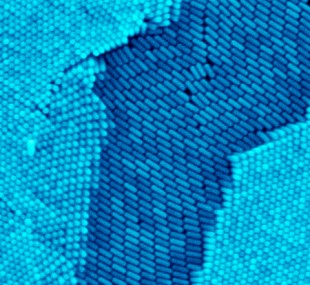Sep 10 2014
Ounce for ounce, gold nanorods that are commercially available cost about 7,000 times more than bulk gold, but that may change, thanks to an award-winning research program in the laboratory of Rice University chemist Eugene Zubarev.
 Because gold nanorods are longer than they are wide, 3-D nanorod supercrystals have "anisotropic" properties, which means they have a different response to external fields in one direction than another.
Because gold nanorods are longer than they are wide, 3-D nanorod supercrystals have "anisotropic" properties, which means they have a different response to external fields in one direction than another.
Zubarev won a three-year grant from the National Science Foundation (NSF) in 2011 to develop new methods for large-scale synthesis and self-assembly of gold nanorods; based on his early progress, the NSF awarded Zubarev one of its most rare honors — a two-year funding extension for “special creativity.”
Just how rare are “special creativity” grant award extensions? Out of more than 43,000 active NSF grants in 2013, only 30 were chosen for the extensions, and NSF has awarded fewer than 700 creativity extensions since the program began in 1995.
“We published 25 papers with the original funding, and some of our results were reported in Chemical & Engineering News,” Zubarev said. “Program managers pay attention to that, as well as to the impact factor of the journals where results are published.”
Zubarev becomes the fourth member of Rice’s faculty to receive an NSF creativity extension for work done at Rice. Other winners are physicist Bruce Johnson, chemist Gustavo Scuseria and biochemist Michael Stern. Engineering Dean Ned Thomas won three creativity extensions prior to joining Rice.
Zubarev said the additional two years of funding will allow his group to continue their efforts to develop methods for large-scale production and processing of gold nanorods. The nanoparticles, which are typically about 75 nanometers long and 25 nanometers wide, have been studied for possible use in medical diagnostics and photothermal therapy of cancer, solar cells, sensors, metamaterials and optical devices.
Prior work in Zubarev’s lab led to a 2008 patent that was licensed by a company that now manufactures most of the commercially available gold nanorods (sold through Sigma-Aldrich). But Zubarev said further advances are needed if gold nanorods are to find widespread commercial success.
“If you look at existing synthetic methods, the yield of the reaction is extremely low, and the quantity you can make in one batch is also very small, usually a fraction of a milligram,” Zubarev said. “If we want to talk about real-life applications, we have to discover new methods that can generate much more than that.”
To address the problem, Zubarev’s team began by examining current batch processes to see whether they could produce more nanorods simply by changing the speed of chemical reduction and the nature of reducing agent.
“The reaction takes place in water and at room temperature,” Zubarev said. “Essentially, we take gold chloride and reduce it with ascorbic acid. In order to produce nanorods from the reaction, one must first introduce ‘seed particles’ of pure gold. Once that is done, a characteristic dark brown color will appear in solution, indicating that small seed particles are getting bigger and bigger and becoming rod-shaped nanocrystals.”
One problem in scaling up the reaction is the incomplete understanding of how it occurs. For example, the seeds are tiny gold spheres, and it is unclear why the reaction forms elongated gold nanorods rather than a uniform batch of large gold spheres.
“It’s been almost 20 years since this method was discovered, and people are still debating the actual mechanism of the reaction,” he said. “One interesting thing people have found is that adding a small amount of silver ions will allow you to produce more rods and fewer spheres. But once again, why that happens in the presence of silver and not any other metal is still unknown.”
Zubarev said his team has taken a systematic approach to tackling the scale-up problem, and they hope to publish significant new findings in the coming months.
In addition to the issue of high-yield synthesis of nanorods the NSF grant is also supporting research into new processing methods to incorporate nanorods into metamaterials, man-made materials with unique properties that blur the line between material and machine. For example, Zubarev’s team is refining new methods for creating gold nanorod 3-D “supercrystals” that contain many millions of nanorods that are tightly packed in uniform arrangements. Because the rods are longer than they are wide, the supercrystals have “anisotropic” plasmonic and electronic properties, which means they have a different response to external fields in one direction than another.